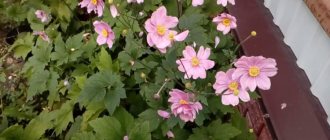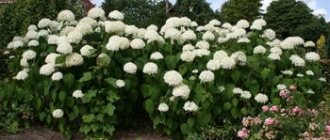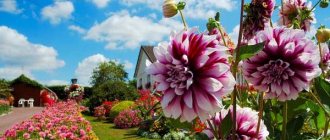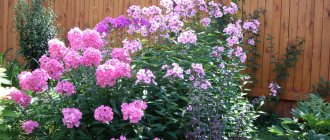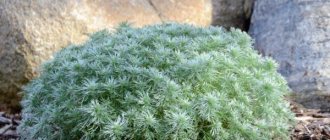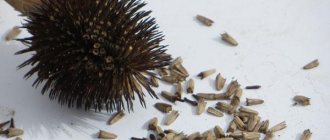Anemone is a perennial herbaceous plant belonging to the genus Ranunculaceae. Anemones (ANEMONEUS) or Anemones are flowers in love with the wind. That is what they are called nowadays. They received this name because of their sensitivity to the slightest breath of wind, which causes the flowers and stems to sway and tremble. The Agronom.guru portal will provide all the detailed information about the plant.
Anemone
Description of the plant
Anemone has very long and developed roots, from which scale-like leaves with long curly petioles extend. In spring, a small stem with leaves grows from the seeds.
The roots are located under fallen leaves, in the top layer of soil.
At the end of the anemone rhizome, buds bloom, from which a white sprout first appears. After snow falls, the shoots straighten.
Anemone has a bare stem that can reach a length of about 60 cm.
The leaves are three-lobed and semi-leathery. Closer to May, the flowers on the anemone become bright yellow with green leaves.
Anemone blossom
Landing technology
Prepared soaked seeds are mixed with light fertile soil in a container for seedlings, moistened and covered with polyethylene, left warm. After the sprouts appear (about a month), the film is removed and the seedlings are placed in a bright, warm place, watered from time to time.
As soon as a pair of true leaves appears on each sprout, they are planted in separate pots.
Anemone seedlings are grown in a greenhouse for the first year, and are planted in open ground only in the fall or next spring.
In regions with mild winters, sowing can be done in the fall, directly into the flower bed. In this case, the seeds do not need stratification - this process will happen by itself over the winter. You just need to take into account that the planting depth should be very small to make it easier for the sprouts to hatch.
Be sure to cover the sowing area before wintering.
The dates for planting tubers and cuttings include April and May or September and October. Planting can be done immediately to a permanent place. To do this, holes are dug in the soil at a distance of at least 10 cm.
The tubers are lowered into the prepared holes to a shallow depth with the flat side up and the elongated side down. If the shape cannot be determined, they are laid flat. The cuttings are placed vertically, the top cut should be flush with the ground level.
Immediately after planting, the soil must be moistened - but in no case too much.
Chemical composition
The chemical composition of anemone is practically unknown. Anemone is one of the poisonous plants in nature, as it contains protoanemonin, tannin, and resins. The leaves also contain ranunculin, which during the drying process is divided into protoanemonin and glucose.
Not many people know that protoamonin is a poison. Externally, it is an oil-like liquid with a pungent odor. All these substances are found in the buttercup anemone.
Yellow anemones
Description
The plant grows in Russia, France, Central Asia and China. Distributed in the steppes to the tundra. Likes to grow in thickets of bushes, dry meadows and clearings.
p, blockquote 3,0,0,0,0 –>
The stem and leaves of the forest anemone are covered with small hairs; they shimmer in the sun and give the plant its charm and tenderness. At the base of the stem there are several branched leaves. The perennial flowers are quite large, have a bright white color and short yellow stamens inside the flower. The leaves of the flowers are round in shape and are partially purple in color at the bottom.
p, blockquote 4,1,0,0,0 –>
Medicinal properties
Anemone contains many beneficial properties that have a positive effect on the human body.
The plant contains:
- ascorbic acid;
- amino acids;
- tannin;
- saponin;
- anemoneal.
Anemone contains many useful substances
Indications for use
Currently, it is practically difficult to prepare drugs that contain anemone, since its full effect on the human body is unknown. But some recipes for various diseases based on anemone still exist.
In most cases, anemone is used in folk medicine. Sometimes it can cure even the most severe disease that cannot be treated with other drugs. Its useful property is in homeopathy.
To use anemone in the treatment of diseases, consult a herbalist or experienced herbalist.
It is better not to create recipes and take infusions on your own; use the help of knowledgeable people.
Herbalists believe that a decoction of anemone is excellent in treating various diseases, since this herb contains many useful substances.
Anemone helps:
- from pneumonia;
- in the treatment of various fungal diseases;
- for tumors;
- for heart diseases;
- for gastrointestinal diseases;
- for oncology;
- for rheumatism;
- for insomnia.
Anemone also has an analgesic, anti-inflammatory and diaphoretic effect on the body. The decoction is also used orally, for example, in the treatment of pneumonia.
Homeopathic medicines should be taken under the supervision of a physician
Recipes
To prepare an infusion of anemone flowers you need:
- 2 tsp. pour anemone herbs with one glass of boiling water;
- leave for a day;
- strain;
- squeeze out;
- take a few sips.
A decoction can also be made from the roots. To do this you need:
- Boil 3 g of roots in 200 ml of water;
- strain;
- squeeze out;
- Use for joint pain.
Anemone extract can be bought at the pharmacy
Recipes for using anemone
Medicinal decoction of anemone rhizome:
- To prepare such an infusion, approximately three grams of the root part of the plant is required.
- The root is crushed, placed in a bowl and filled with a glass of water. The dishes are placed on the fire.
- The root should be simmered over low heat for about half an hour. After this, the decoction is filtered and used only externally in the treatment of the back and joints.
Important: Fresh root can also be used for medicinal purposes. In this form, anemone helps get rid of warts. The root is cut, the juice is squeezed out of it, which is used to lubricate the wart.
Preparation of anemone tincture:
- To prepare a medicinal tincture, you should use the above-ground part of the plant - these are the leaves and roots.
- The above-ground part is passed through a meat grinder to form a crumbly part.
- You will need about a glass of dry ground part of the plant.
- The resulting mass should be poured into a liter glass jar and filled with half a liter of vodka.
- The medicine should infuse for about two weeks in a cool, dark place.
- After infusion, the liquid must be filtered through a sieve to get rid of the cake.
- After this, the tincture can be stored in the refrigerator and used either as a rub or internally.
Important: When scrolling the anemone, all manipulations should be performed with gloves so that the plant part does not touch the skin of the hands and does not cause irritation.
Harvesting grass
In order for anemone to help you in treatment, you need to know when to collect it. At different times of flowering, flowers are filled with useful substances.
It is not recommended to do this on your own, since only experienced herbalists know when to harvest this herb.
It is better to collect anemone in clear and dry weather. It is advisable to cut off the stems along with leaves and flowers entirely. You need to dry the grass in the shade or use a dryer. After drying, you need to pour the anemone into glass jars. Shelf life: 1 year.
Contraindications
In addition to positive effects on the body, the plant also has a number of contraindications. It is forbidden to use decoctions of anemone:
- pregnant women, as the grass can cause abortion;
- taken by people with kidney diseases, because it is this organ that removes all toxic substances from the body;
- for children under 3 years of age.
When treating with anemone tincture, you must follow the dosage indicated by the herbalist.
In case of the slightest poisoning, you should consult a doctor.
But in most cases, taking it as prescribed by the doctor, the treatment takes place without any consequences.
Treatment with anemone has contraindications
Description of the anemone flower and its photo
Anemone, anemone (ANEMONE) belongs to the ranunculaceae family.
According to their description, anemones are so diverse that they should be divided into 2 groups:
1. The best known are spring-blooming species with a short lifespan of leaves (ephemeroids) - low, graceful, they attract the gardener’s eye with their simple flowers. Among them there are species with long jointed rhizomes that form spots, such as oak anemone, and species with tuberous rhizomes that grow in separate bushes, such as v. tender.
Look at what early flowering anemones look like in the photo: all plants have dissected thin leaves and single flowers rise above them on a small peduncle. Plant height is 10-20 cm. They bloom in April-May, and by mid-June the leaves die off.
2. Species of the second group are distinguished by later flowering and a long growing season, since their leaves are retained from spring to autumn. Among them, species with a thick rhizome and an erect stem 12-45 cm high extending from it stand out. 3-5 peduncles rise on the stem, ending in an umbrella-shaped inflorescence. These species form bushes (for example, V. daffodil). A number of late-blooming root shoot anemones form thickets.
As you can see in the photo, these varieties of anemone are very interesting, long-flowering plants, attractive all season long, especially the hybrid anemone.
Group I - unstable-decorative anemones, ephemeroids with a long rhizome:
Altai anemone (A. altaica) and Amur anemone (A. amurensis).
Flexible anemone (A. flaccida) and oak anemone (A. nemorosa).
Anemone (A. udensis) - has white flowers, anemone (A. ranunculoides) has yellow flowers.
Spring-flowering ephemeroids with tuberous rhizomes:
Caucasian anemone (A. caucasica) and Apennine anemone (A. apennina).
Tender anemone (A. blanda) - have flowers of lilac and blue tones, and crown anemone (A. c oronaria) - flowers of all colors (except yellow).
Group II - stable and decorative anemones, blooming from June to August:
Long-haired anemone (A. crinita) and narcissiflora (A. narcissiflora) are distinguished by the presence of an umbrella-shaped inflorescence of white flowers; they grow in bushes.
Forked anemone (A. dichotoma).
Canadian anemone (A. canadensis) and forest anemone (A. sylvestris) form thickets up to 40-60 cm high from erect stems with deeply divided leaves and single white flowers on long pedicels.
The hybrid anemone flower deserves a special description - it is the most beautiful and varied in color (from white to cherry), it has an umbrella-shaped inflorescence of large (up to 8 cm in diameter) flowers that open in mid-July and persist until mid-September.
Varieties:
"Bressingham Glow" - pink-red.
"September Charm" - pink.
"Konigin Charlotte" - silvery pink.
"Prinz Heinrich" - purple-red.
Types of anemone
Anemone has quite a few species and varieties that grow not only in Russia.
Let's look at the most famous ones below:
- Common anemone. This is the most famous species that can be found in the garden of almost any gardener. The common anemone blooms only in spring. This species has single large flowers in white, red and purple. Height - 20 cm. Another name for this species is common lumbago, better known as sleep grass. This species can be found on sunny edges and in the shade of trees.
- Anemone is tender. Anemone flowers are shaped like daisies. Flowering begins by the beginning of April. Tender anemone is quite small in size - up to 10 cm. Tender anemone can be seen in large sunny areas.
- Crown anemone. This species reproduces only by tuberous segments. Crown anemone - the queen of anemones, has very large and bright flowers, which attracts people's attention. Anemone of this type can be blue, as well as red, and may even have a crimson tint. Crown anemone grows in the southern regions and beyond. The height of the bushes is 50 cm in length.
- Oak anemone. The height of the bush is from 20 to 30 cm. Most often it is only white, but there are varieties with blue and pink flowers. Oak anemone has a large developed rhizome. For its good development, loose and moist soil is required.
- Anemone buttercup. This species begins to grow in early spring in the forests of the European part of Russia. Anemone blooms with bright yellow flowers. Height - 25 cm. In most cases, buttercup anemone is found in shady places in the forest.
- Forest anemone. Height is about 50 cm with large large white flowers. Appears by the end of May - beginning of June. This species prefers to grow in the sun.
- Japanese anemone. This bush reaches a height of about 40 cm. The leaves are most often dark in color, and the colors of the buds are very different - from pale to the brightest and most saturated.
- Anemone Udinskaya. A rather low plant, 10 cm in length. The leaves of this species differ from others in their thinness and tortuosity. In the middle there is one flower 3 cm in diameter. They look quite unusual.
- Blue anemone. Grows in the southern part. It begins to bloom by mid-May. The height of the bushes is only 20 cm. Blue anemone has a creeping horizontal rhizome.
- Altai anemone. It grows in the southwest of Eastern Siberia, in the European part of Russia, and in Japan. The plant begins to bloom in early spring. The flowers are most often white with a purple tint in the middle. The flower has quite a lot of petals from 8 to 12.
- Tufted anemone. Can be found in Central and Southern Europe. Plant height is about 60 cm. Grows very well in sunny areas with loose soil.
- Felt anemone. Grows in height up to 120 cm. One of the hardy and cold-resistant species. Blooms from early August to September.
- Anemone lipsiensis. This species boasts rapid growth. The flowers of the plant are warm colors. Most often found in the forests of eastern Russia.
Richness of anemone species
Tender beauty at the spring flower festival
When spring comes to earth, and the earth puts on a lush outfit of flowers, you involuntarily want to smile and enjoy life. Looking at the delicate petals of the anemone, it seems that Cinderella is at a flower festival. But once you take a closer look, it is impossible to pass by such a modest beauty.
Anemone belongs to the Buttercup family and is a perennial herbaceous plant. It grows throughout the Northern Hemisphere, where the climate is relatively temperate. It can be seen on forest edges and vast meadows, on mountain slopes and in river valleys. Wherever an anemone (another name for a flower) appears, it gives spring warmth and a smile to people.
This modest plant can grow from 10 to 100 cm in height. The buds come in a variety of colors. Here are some of them:
- snow-white;
- blue;
- blue;
- yellow;
- pink;
- lilac.
Flowers consist of five (sometimes 7 or 8 pieces) delicate petals, which can be semi-double or double. They are held on long single peduncles. Anemones bloom in early spring (in colder places in April or May), which attracts the attention of garden plant lovers.
Thanks to the painstaking work of breeders, new varieties of anemone were developed. Some of them bloom in July or September. With a wise approach to growing flowers on your site, you can plant different varieties of anemone. As a result, the flower festival will last the whole season.
The anemone plant has three-dissected long-petioled leaves. They are located on short petioles, 3 pieces together. Near the root system there is sometimes a single leaf or no leaf at all. Interestingly, the smooth cylindrical rhizome is capable of quickly throwing out shoots. Therefore, flowers often form entire colonies, turning the area into a luxurious carpet.
In June, when the lush flowering leaves, fruits appear on the anemone. They are an oblong sac with a huge number of seeds. The achene carried away by the wind often ends up in new territories, where delicate spring flowers may appear.
Growing anemone in the garden
Very often this flower is planted in the garden just for beauty. Before planting, you need to find a suitable place and then prepare it properly. A properly prepared place is the key to good flowering of the plant.
For planting, it is best to find a place in the shade where the plant will not be exposed to wind or draft. You can plant it in a place where the sun's rays will penetrate at least a little.
It is best to plant anemone in loose peat or loamy soil. To improve the composition of the soil, you can add a little sand and wood ash.
Decoration of any garden
Before planting, you need to prepare the anemone seeds. The seeds need to be planted in small boxes with soil prepared in advance. Afterwards, the boxes need to be buried in a plot in the garden, not very deep.
The seeds should be kept under the ground and snow all winter, and then they should be dug up and planted.
You can plant them either in separate small pots or directly in open ground. It is not recommended to leave them in pots for too long, as the root system spreads too quickly.
Anemone in the garden
Before planting in the ground, it is advisable to place the tubers in warm water to bring them out of dormancy. You need to leave it in water for only 2-3 hours, and then plant it in open ground. Even for inexperienced gardeners this will not be difficult.
It is worth noting that the anemone grows very quickly, which is why after about 3-5 years you should think about transplanting it to a new place.
You can simply separate one part and plant it in another place. In most cases, the anemone tolerates this procedure calmly and takes root well in its new location.
Only hybrid anemones do not like transplanting. In most cases, they try not to touch them. But if this is necessary, then this should be done in the spring.
During transplantation, it is not necessary to dig up the whole clump; you just need to separate the root system with buds or sprouts. Carefully separate and transfer to the prepared well. If you want to move the whole anemone to a new place, then you should dig up the entire tubers, and then dig up the ground thoroughly to make sure that nothing is left there.
After transplanting to a new location, water the soil and then feed it with fertilizers. At this time, you need to pay special attention to plants.
Caring for anemones will be easy if you follow 3 simple requirements:
- Timely watering. Anemone does not withstand drought and loves moisture very much, so moderate watering will be very helpful.
- Proper feeding. For the growth of young tubers, it is necessary to add mineral fertilizers that contain nitrogen to the soil. It is worth fertilizing the soil no more than several times per season.
- Loosening. Two or three times a year it is necessary to loosen the soil around the anemone. You can also add wood ash to keep the soil acidity level low.
Flowerbed with anemones
Spring and autumn flowering
Anemone blooms in autumn and spring. Spring plants are very beautiful and graceful and have a fairly wide range of colors and shades.
Spring anemone begins to grow in April, and closer to July the flowering ends.
Many types of anemone persist until autumn. At this time you can also find different shades of flowers, although not as rich and bright as in spring.
Anemone propagation
There are 2 ways to propagate anemone:
- seed;
- vegetative.
Reproduction using seeds is quite difficult. This requires seed stratification. The planting is expanding only thanks to this method of propagation. In most cases, experienced gardeners use this method.
The material for sowing must be made together with soil and sand if you want to propagate anemones by seeds.
Afterwards, the material must be properly moistened and refrigerated for about 3-4 weeks. In this case, the temperature in the refrigerator should not be higher than +6.
During this time, see if sprouts appear earlier.
Anemone seeds
At the first manifestations, the material must be removed from the refrigerator. During this time, the seeds have already softened and the embryo gradually awakens.
After the embryo appears, it can already be planted in open ground in the garden. Anemones are accepted quite quickly and do not require special care.
Vegetative propagation of plants is much simpler. Some species, such as Canada anemone or forest anemone, produce suckers, which are then cut off and planted in the ground. It is best to carry out work in early spring.
Other species, Altai or Amur, form separate fragments with their rhizomes, which can be divided into parts and planted without digging.
Tubers reproduce well with anemones - tender or Caucasian. They are dug up by the end of July and stored until spring, then planted in the ground. Each anemone tuber is divided into several parts, dried and then sprinkled with wood ash.
Anemone sprouts
Anemone planting site and soil for it
Anemones (especially ephemeroids) are usually grown in shaded areas of the garden - for example, under the canopy of trees or next to shrubs. Autumn species, on the contrary, should be planted in well-lit beds. Tender anemone also loves sunlight, despite its belonging to the ephemeroids.
If the planting material is of unknown origin and the variety is difficult to determine, it is better to plant in the shade.
It should be borne in mind that this plant has a strong root system, which branches into many branches during the growth process, and it can have a depressing effect on its herbaceous neighbors, displacing them. In such cases, the resulting curtains must be seated.
Many types of anemones feel better in loose soil saturated with humus. The exceptions are forest and rock anemone, which grow well everywhere.
Blue, tender and rock anemone are accustomed to calcareous soil, so to grow them, dolomite flour or ash is added to the ground.
Diseases and pests of anemones
Anemone is susceptible to various diseases and pest attacks. In order not to start the disease, you need to pay attention to even the slightest signs.
To save a plant, you need to determine the type of disease or pest in order to begin the fight.
Diseases:
- Viral diseases. Symptoms: Leaf spotting, growth abnormalities, mosaic patterns, slow growth. Control measures: in this case, diseased plants urgently need to be removed so that others do not become infected.
- Sclerotinia. Signs: rotten roots that die in entire nests. Control measures: urgently remove the affected areas along with soil and roots. Treat the remaining plants with Rovral.
- Downy mildew. Signs: there are white spots on the leaves and a coating below. Control measures: spraying with copper oxychloride or Previkur.
- Anthracnose. Signs: growth anomaly, curly foliage, young shoots take on an ugly shape. Control measures: if a problem is detected, treat the bushes with Cumulus or Euparen.
Sclerotinia damaging anemone tubers
Pests:
- Aphids. Symptoms: yellow curly leaves. Control measures: In case of severe damage, the plant should be treated with Actellik or Akarin or Aktara. In case of single damage to the bushes, it is necessary to cut them off along with the leaves.
- Leaf miner. Signs: Small yellow punctures can be seen on the leaves. Control measures: the affected areas should be removed, and then the remaining flowers should be treated with Actellik or Fufanol.
- Leaf nematodes. Signs: yellow leaves at the corners of a brownish color. Control measures: affected flowers are removed, and the rest are transferred to dry storage. Foliage cannot be sprayed.
- Thrips. Signs: A yellowish-white color can be seen on some leaves, and there is also a dark discharge on the underside of the leaf. Control measures: spraying leaves and flowers with Tanrek or Fitoverm.
Aphids on anemone
Anemone: cultivation and propagation
Growing conditions. Anemones belonging to group I are forest plants that grow well in the shade, on loose fertile soils with moderate moisture. Tuberous anemones are more heat-loving and drought-resistant.
Anemones of group II grow well in partial shade and in open areas, with loose soils, moderate moisture.
Reproduction. It is preferable to propagate all anemones vegetatively, that is, by segments of rhizome with a renewal bud, or a root shoot, or a piece of tuber. The period of reproduction depends on the period of flowering. Spring-blooming ones are propagated and replanted in the summer, summer-blooming ones - in the spring. Reproduction by seeds is possible, but success is not guaranteed, since in most species the seeds have difficult germination. The planting density of ephemeroids is 20 pcs. per 1 m2; Autumn-blooming large anemones are planted in 5 pieces. per 1 m2.
Combination in a flowerbed with other plants
Among flowers there are individuals with similar and dissimilar habits. If you place plants in the same flowerbed, then you need to select them so that they have the same requirements for light and humidity.
Anemone behaves quite aggressively with other representatives, as it sucks out from the soil all the nutrients necessary for growth. Moreover, it is this family that can poison the lives of other green “brothers”.
But, nevertheless, in the same flower bed with anemone there can be bulbous and ground cover crops. Next to the anemone there may be lily of the valley, fern, liverwort, chrysanthemums, and verbenas.
Colorful flower bed with anemone
Anemone flower: description of species, planting and care
If the description of the anemone flowers seems too simple to you, a big surprise awaits you: despite their apparent modesty, these plants can decorate your garden in the most unpredictable ways, and precisely because of their gentle simplicity. And considering that their forcing can be timed to coincide with the desired dates (for example, holidays) regardless of the season, the attractiveness of anemones will increase even more.
Anemone
anemone, anemone, snowdrop, chickenblind, drip, freckle
A small flower, depending on the type of white, red, yellow, blue flowers. It grows both in the Northern Hemisphere and in Africa. Blooms in spring. Highly poisonous. Can be used in traditional medicine. Roots and aerial parts are used. Anemone-based products have an antiseptic, analgesic, diaphoretic, and sedative effect. Due to toxicity, alternative options are recommended.
Name in Latin: Anemone Family: Ranunculaceae
The primrose plant with carved leaves and delicate flowers is popularly called anemone. Its official name is anemone, otherwise anemone. It is a potent, highly toxic agent. According to some representatives of traditional medicine, anemone has a number of beneficial properties. But since it is poisonous, you need to be as careful as possible when collecting raw materials, preparing and using products based on it.
Anemone extract is produced by the pharmaceutical industry and is commercially available. However, using the plant yourself to prepare folk remedies is very dangerous, since there is a high risk of making a mistake with the dosage.
The Russian and Latin names of the plant are associated with the word wind. Leaves and petals can sway even at the slightest breath. In Greece, the birth of the anemone is associated with the legend of Adonis. The hero died because he did not respond to Athena's love. From drops of the young man’s blood, scarlet anemone flowers were born. According to another legend, the anemone appeared during the expulsion of Adam and Eve from paradise. The angry Lord first hit them with cold. And then, having regret, he turned the snowflakes into flowers. Therefore, anemone appears in early spring, immediately after the snow melts.
Depending on the species, the flowers have different colors. Forest anemone is listed in the Red Book of Russia. This is another reason to look for alternative options instead of treating with this plant.
